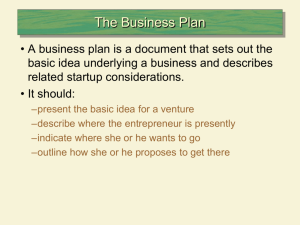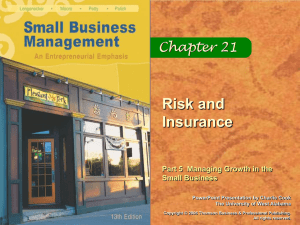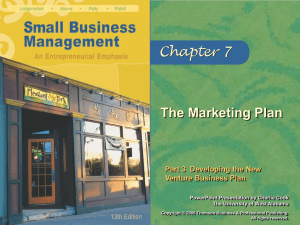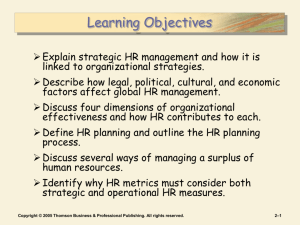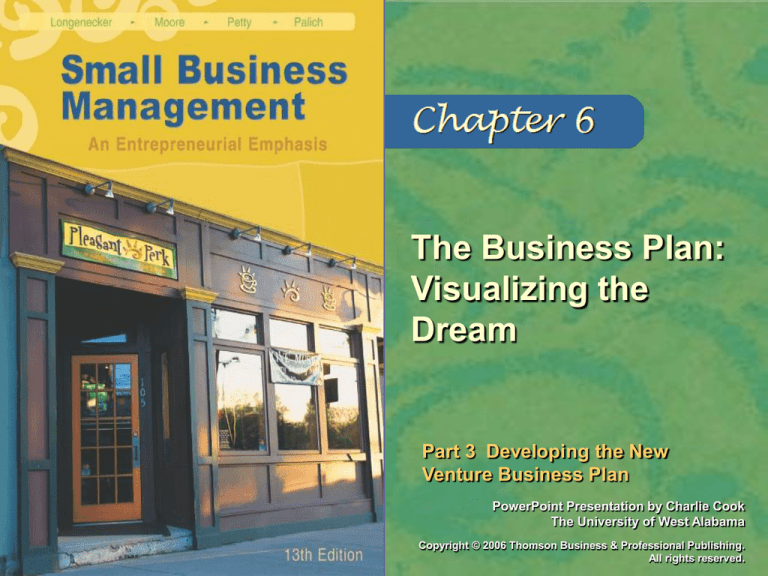
The Business Plan:
Visualizing the
Dream
Part 3 Developing the New
Venture Business Plan
PowerPoint Presentation by Charlie Cook
The University of West Alabama
Copyright © 2006 Thomson Business & Professional Publishing.
All rights reserved.
Looking Ahead
After studying this chapter, you should be able to:
1.
2.
3.
4.
5.
Explain what a business plan is, when it is needed,
and what form it might take.
Explain how to tell a new venture’s story to outsiders,
especially investors.
List practical suggestions to follow in writing a
business plan and outline the key sections of a
business plan.
Identify available sources of assistance in preparing a
business plan.
Maintain the proper perspective when writing a
business plan.
Copyright © 2006 Thomson Business & Professional Publishing. All rights reserved.
Student 6–2
The Business Plan
• A business plan is a document that sets out the
basic idea underlying a business and describes
related startup considerations.
• It should:
–present the basic idea for a venture
–describe where the entrepreneur is presently
–indicate where she or he wants to go
–outline how she or he proposes to get there
Copyright © 2006 Thomson Business & Professional Publishing. All rights reserved.
Student 6–3
The Business Plan (cont’d.)
• A business plan has three basic objectives:
–to identify the nature and the context of a business
opportunity
–to present the approach the entrepreneur plans to
take to exploit the opportunity
–to recognize factors that will determine whether the
venture will be successful
Copyright © 2006 Thomson Business & Professional Publishing. All rights reserved.
Student 6–4
The Business Plan (cont’d.)
• A business plan may be of secondary
importance if the environment is turbulent or if
timing is such that the company needs to start
operations as quickly as possible rather than
slow down to write a business plan.
• The summary plan is a short form of a business
plan that presents only the most important
issues and projections for the business. This
may be ideal if the entrepreneur is short on time
or is facing a great deal of uncertainty about the
future of the company.
Copyright © 2006 Thomson Business & Professional Publishing. All rights reserved.
Student 6–5
The Business Plan (cont’d.)
• A comprehensive plan is beneficial when:
–(1) describing a new opportunity (startup)
–(2) facing significant change in the business or the
external environment (changing demographics, new
legislation, or developing industry trends)
–(3) explaining complex business situations
Copyright © 2006 Thomson Business & Professional Publishing. All rights reserved.
Student 6–6
Purposes of the Business Plan
• The business plan can serve as an effective
selling tool with prospective customers,
suppliers, and investors.
–In seeking financing, an entrepreneur must first use
the business plan to create interest in the startup and
then follow up with a formal offering memorandum to
those investors who seem genuinely interested.
• When writing the business plan, remember that:
–(1) investors have a short attention span
–(2) certain features appeal to investors, while others
are distinctly unappealing
Copyright © 2006 Thomson Business & Professional Publishing. All rights reserved.
Student 6–7
Writing the Business Plan
• To maximize the effectiveness of a business
plan, write clearly and provide factual support for
any claims made.
• The entrepreneurial team, the opportunity, the
resources, the deal structure, and the “big
picture” are all interdependent factors that
should be given consideration when thinking
about the content of a business plan.
Copyright © 2006 Thomson Business & Professional Publishing. All rights reserved.
Student 6–8
Writing the Business Plan (cont’d.)
• Key sections of a business plan are:
– (1) title page
– (7) marketing plan
– (2) table of contents
– (8) management plan
– (3) executive summary
– (9) operating plan
– (4) vision and mission statement
– (10) financial plan
– (5) company overview
– (11) appendix of supporting
documents
– (6) products and/or services plan
Copyright © 2006 Thomson Business & Professional Publishing. All rights reserved.
Student 6–9
Writing the Business Plan (cont’d.)
• Common mistakes often made by entrepreneurs
when preparing a business plan include:
–(1) failing to provide solid data
–(2) failing to describe the product in lay terms
–(3) failing to thoroughly analyze the market
–(4) including financial statements that are overly
detailed or incomplete
–(5) hiding weaknesses
–(6) overlooking the fatal flaw
–(7) using bad grammar
–(8) making the plan overly long
Copyright © 2006 Thomson Business & Professional Publishing. All rights reserved.
Student 6–10
Assistance with Business Plans
• A variety of books, Web sites, and computer
software packages are available to assist in the
preparation of a business plan.
• Professionals with planning expertise, such as
attorneys, accountants, and marketing
specialists, can provide useful suggestions and
assistance in the preparation of a business plan.
• The Small Business Administration (SBA), the
Service Corps of Retired Executives (SCORE),
and the FastTrac Entrepreneurial Training
Program can also be helpful.
Copyright © 2006 Thomson Business & Professional Publishing. All rights reserved.
Student 6–11
Beyond the Business Plan (cont’d.)
• Despite the potential benefits of a well-drafted
plan, good judgment should be used in deciding
how much to plan in view of the specific
circumstances.
• The business plan, no matter how beneficial, is
not the business. A good business plan leads to
a successful company only when it is effectively
executed by the entrepreneur and the
management team.
Copyright © 2006 Thomson Business & Professional Publishing. All rights reserved.
Student 6–12
Beyond the Business Plan (cont’d.)
• A business plan can be viewed as an
opportunity for the entrepreneur and the
management team to think about the potential
key drivers of a venture’s success or failure.
Copyright © 2006 Thomson Business & Professional Publishing. All rights reserved.
Student 6–13
Key Terms
business plan
summary plan
comprehensive plan
prospectus
executive summary
mission statement
products and/or services plan
marketing plan
management plan
operating plan
financial plan
pro forma statements
Copyright © 2006 Thomson Business & Professional Publishing. All rights reserved.
Student 6–14

